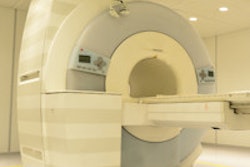
Do you need a CT scanner or other capital equipment for your radiology department, but aren't sure how to seal the deal? The road from recognizing a need to powering up that million-dollar machine can be long -- and strewn with potholes that only planning and preparation can fill, according to CT expert Dr. Geoffrey Rubin.
At the International Society for Computed Tomography (ISCT) 2016 Symposium in June, Rubin, who was course director of the San Francisco meeting, laid out six steps to make new CT scanner decisions happen: define, validate, research, strategize, project, and communicate.
 Dr. Geoffrey Rubin from Duke University.
Dr. Geoffrey Rubin from Duke University."The fundamental principle you have to recognize -- unless you're the guy writing the check -- is that basically the purchase of anything in the healthcare system involves other people's money," Rubin said. "By other people's money, we're talking about dollars, the dedication of other people in the system -- who are, in a sense, money -- and people's time, space in order to site the new scanner, and competing alternatives in this effort."
People being asked for money always know they're the ones with the resources, and they're the ones who can make the potential buyer jump through hoops to get what they need.
"So you have to be prepared to win the day," said Rubin, who is a professor of radiology and bioengineering at Duke University.
1. Define the problem
The first step is defining the problem the new scanner is going to solve, Rubin said.
"Saying, 'I have to give a talk next week, and I really need a new state-of-the-art scanner,' is probably not going to be as compelling as, 'We have a two-week backlog in our scan bay, and we need a new scanner,' " Rubin said.
When framing the question, it's also essential to understand whose problem it is.
"If possible, make it the problem of the person with the money," Rubin said. "It's not going to be as effective to communicate the problems that you have. Make it about the organization. Make it about the institution."
And be sure to determine how you will know the problem has been solved, he said. Think about target metrics. Perhaps you need to have an appointment available on an outpatient basis within one day 90% of the time, and within three days 100% of the time.
"It's about defining the need, framing it in the interest of the person who's going to support it, and having a clear way to know that it's been solved," Rubin said.
2. Validate the need
Once you have a general idea of your goal, don't settle for what you think is right, Rubin said. Open the process up to others who can question your ideas and serve as your allies.
"Talk to people, get advice, and get your trusted advisers to bounce these ideas off of them, but also build a team of diverse constituents," he said.
If it's a CT scanner you're looking to buy, for example, bring in a couple of referring clinicians, a couple of technologists, and the department administrator. Sit down with them and talk through the issues -- being careful to mitigate radiology-centric views in favor of an organization-wide focus.
"Make it about the organization; make it about the institution," he said. "Come up with solutions that are organizationally centric."
As for tools, there's nothing like role-playing to really get in the head of the CEO who must ultimately support the project. Role-playing "may seem a little bit trite, but it's very effective when working as a team to try to think through potential barriers that might emerge downstream," Rubin said.
3. Research the solution
Take time to research and really understand the solution you are proposing, according to Rubin. Think about the universe of alternative solutions to the problem that do not involve buying a CT scanner.
"If it's a simple problem of a backlog, maybe it's a matter of opening a new shift, and that's not going to get you a new scanner," he said. "What are the competitors to the idea that you have? At the end of the day, data rule. Take the time to understand the solution you propose."
The potential buyer must confirm that the need really exists, and that means sharing data that prove it. For example, why not create a graph showing four years of the inverse relationship between CT backlog days and patient satisfaction? This approach is organizationally focused.
"Think broadly about the metrics you're going to collect," he said. "They might be operational in terms of delay or in terms of workflow through the department. They may be financial; they may relate to quality and safety; they may be patient satisfaction-related or staff satisfaction-related. Cast a wide net to build your case."
4. Strategize
Once your plan is in place, expand your team so that it includes stakeholders throughout the organization, Rubin said. Visualize the approval process and explore what it will take to achieve it.
Determine who is going to be involved in making the ultimate decision, visualize the process, and formulate a specific plan to get from point A to point B. Get the key decision-makers involved in your effort to "lubricate the decision engine," he said.
5. Project
You need to lay out plans to get where you need to be, Rubin said. Detailed plans will be indispensable for convincing key stakeholders of the worthiness of the project.
There will be a facility conversion period as the new scanner is installed, requiring a project timeline. There will be downtime as the scanner is installed and also personnel training needs, all of which must be articulated and shared.
An operational plan is needed to explain what will be different once the new scanner is installed. How will the scanner be staffed? How will the service change? Financial projections are needed to explore how the new scanner will affect the bottom line.
6. Communicate
Once the plan is in place and you're prepared to gain approval, it's time to study the presentation and all of the potential questions that may arise.
Preparation for this step "shows you have really thought through everything, considered contingencies, and shared those plans with key stakeholders," Rubin said.
Know the details of the responses, and anticipate the questions in advance, he said. There will be a written plan but also an oral presentation.
Being thoroughly prepared for your presentation will help you avoid the drama of getting questions you haven't thought of -- questions like, "'Why don't we just buy the used CT scanner that the practice down the street that's going out of business is willing to sell us for half-price?" Rubin said. "You need to anticipate these things."
"Organize your planning around these steps, and you, too, can be the proud owner of a new CT scanner," he said.



















